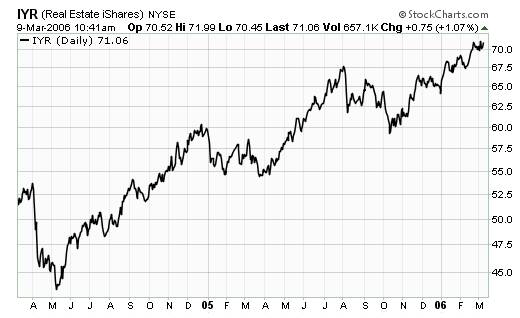| Home | About Us | Resources | Archive | Free Reports | Market Window |
A Clear Change of a Giant Trend...By
Friday, March 10, 2006
I looked at over 50 charts yesterday. I looked at charts of international stock sectors like mining, real estate, transport, retail, banking, tobacco, industrials, insurance and energy. I covered them all... the whole world’s stock market, on a sector-by-sector basis. Every chart I looked at had moved higher since late 2002. There wasn’t a single exception. Some sectors had doubled. Others had tripled or quadrupled... but they all had that same upward-sloping line in common. Inflation is the common denominator among all of them. The central banks of the U.S., Japan, and Europe – the three largest – have spent the last five years producing enormous quantities of financial liquidity. This money was designed to lift the global economy out of recession. As shown by the rise of all asset prices, it clearly worked. The Bank of Japan started first, cutting interest rates to approxmiately zero and dropping 27 trillion yen into the global currency market between 2002 and 2004. The U.S. Federal Reserve followed, cutting its base rate to the lowest level since 1958... and holding it there for over a year. Europe joined the party in 2001, cutting rates to 2% and growing its paper money supply by over 7% a year since 2003. These were fantastic levels of liquidity... the trend of cheap money was a giant one, and it pulled stocks and real estate along with it. This trend has now changed. Last week, the European Central Bank pushed its interest rate up... again. Interest rates in Europe had been on hold for three years. Yesterday, a bigwig in the European Central Bank implied there would be more rate hikes. There is still a “considerable excess of liquidity,” he said. There’s more... this just in from Japan: we received news this week that Japan has officially scrapped their policy of ultra-low interest rates. The U.S. tightening cycle is more mature. The Fed has already raised rates 14 times and U.S. rates are now among the highest in the developed world. The futures market predicts three more hikes later this year. When interest rates were still around 1%, pessimists predicted a rate hike campaign would crush the fragile American economy. They were wrong. Higher rates haven’t had any obvious impact on prosperity. An analyst from Goldman Sachs thinks European inflation neutralized the blow. “Just as our liquidity measure finally began to slow in the United States late last year after 12 months of Fed tightening,” explains the analyst, “it began to boom in Europe.” In other words, the special in-house inflation indicator used by Goldman showed European inflation took up the slack after U.S. inflation withered. It makes sense. The world is so connected now. As long as there is at least one central bank providing easy credit, everything’s fine. We only feel friction when all three tighten simultaneously. We’re feeling friction now. The world’s riskiest stock markets (like Russia) have taken big hits this week. The trend of easy money I described earlier is ending. It may cause the other trends to end as well. Proceed with caution. Good Investing, Tom Dyson Market NotesMARKET NOTES Count DailyWealth as surprised as anyone by the chart below… We’re surprised by the robust and rising stock prices of publicly traded real estate firms like Equity Residential (EQR), the largest publicly traded owner of apartment buildings in the US, and Simon Property Group (SPG), the nation’s largest shopping mall owner. Along with the rest of America’s largest Real Estate Investment Trusts (REITs), Equity Residential and Simon Property make up the iShares Dow Jones U.S. Real Estate Index Fund (IYR). This exchange-traded fund tracks the general conditions of the REIT industry, good or bad. As the chart shows, despite climbing interest rates, these stocks are still hitting new highs. Surprising new highs… the iShares Dow Jones U.S. Real Estate Index Fund:
-Brian Hunt |
Recent Articles
|


